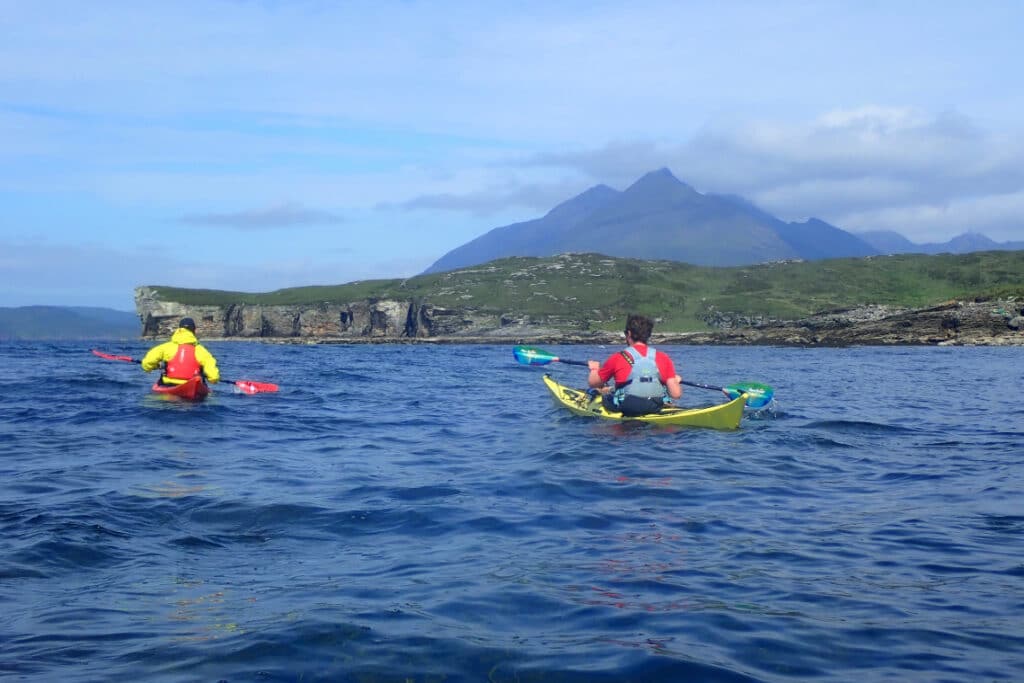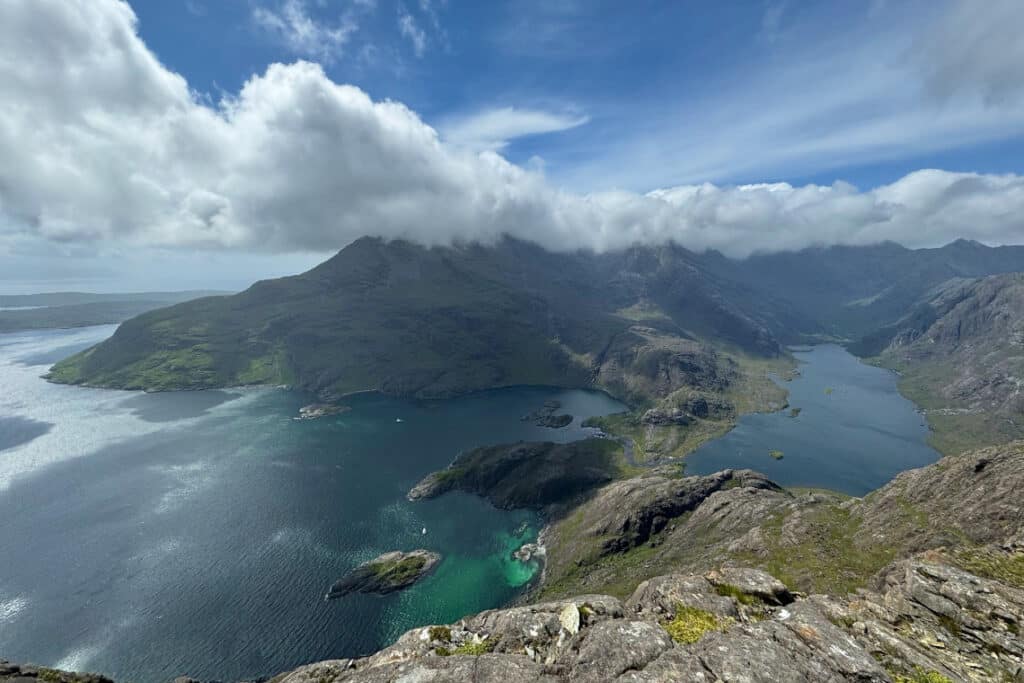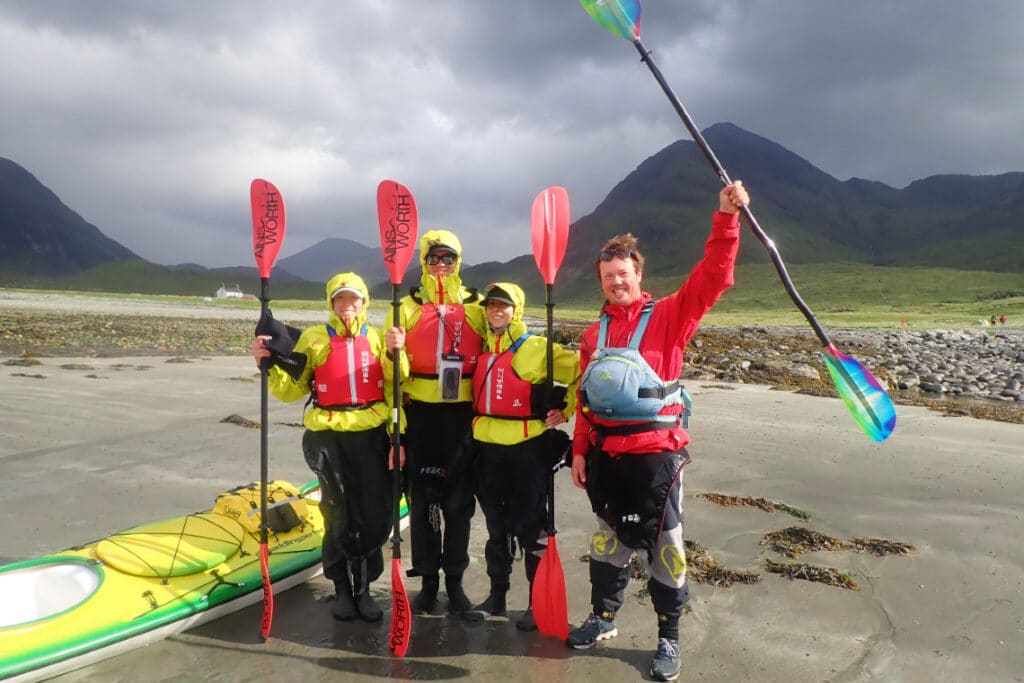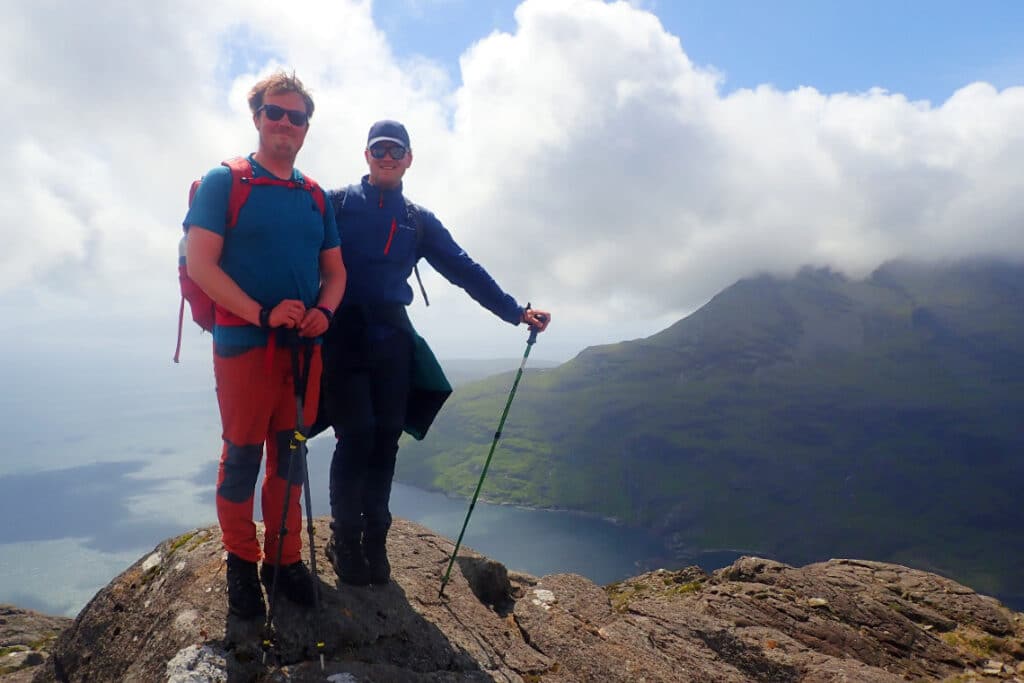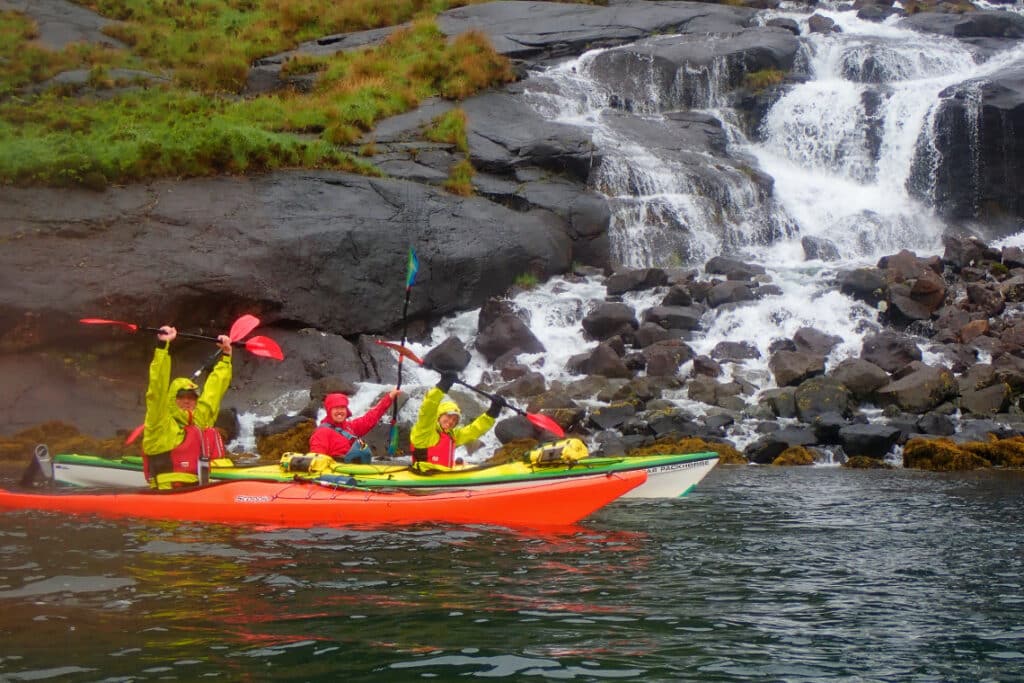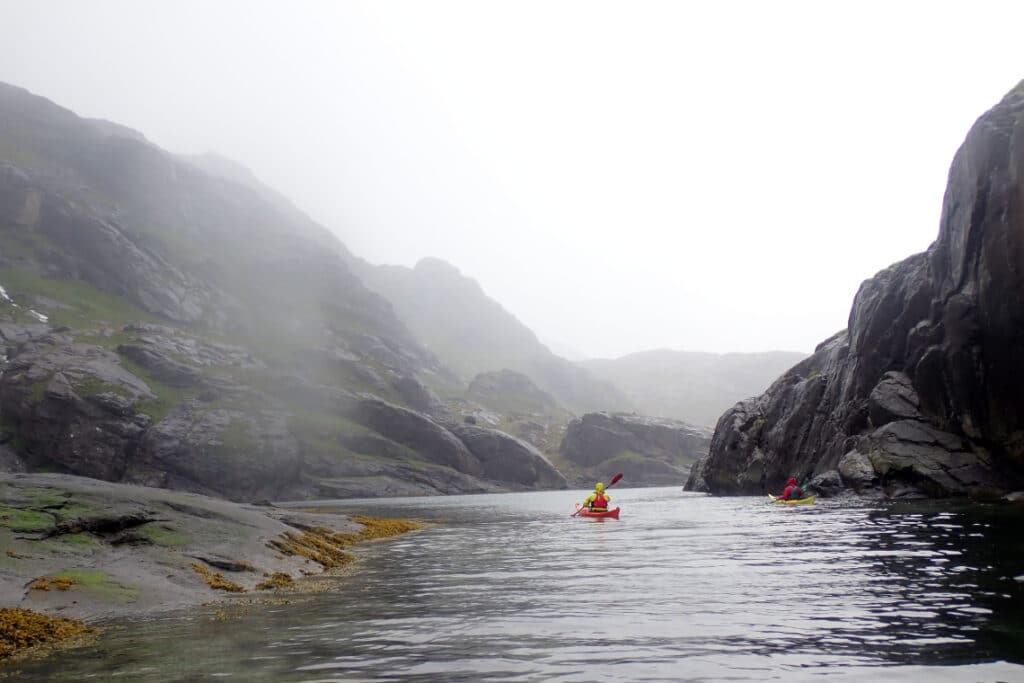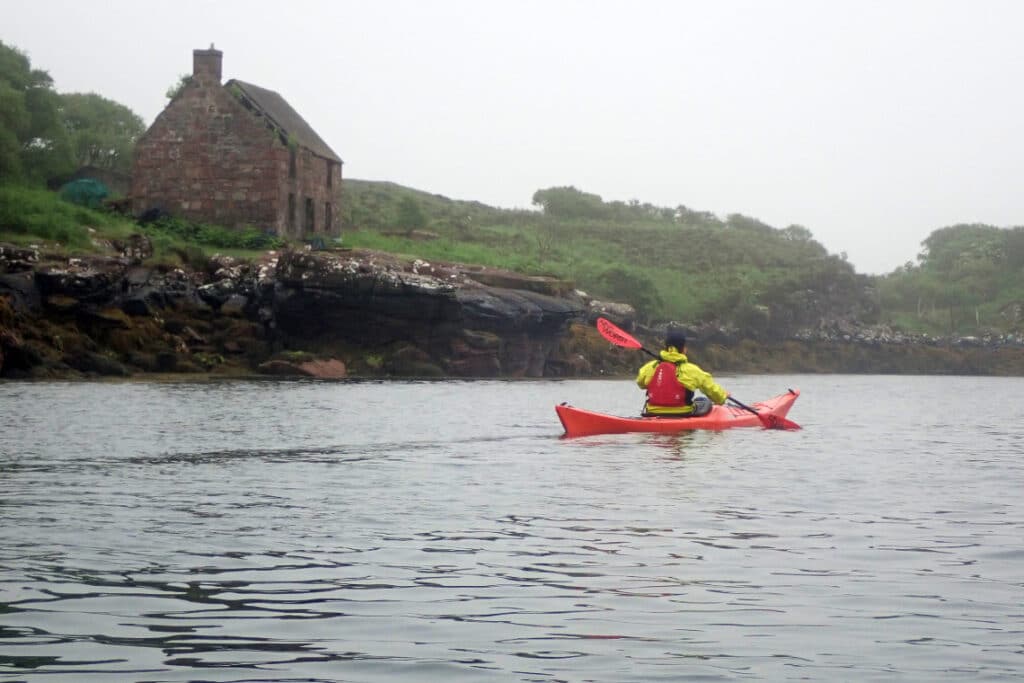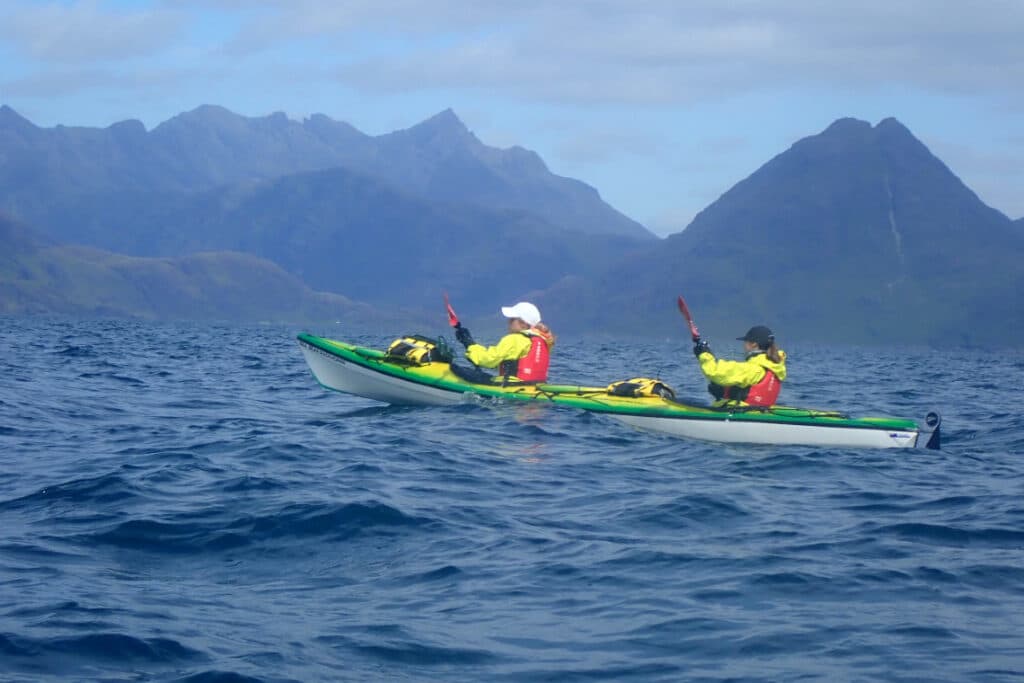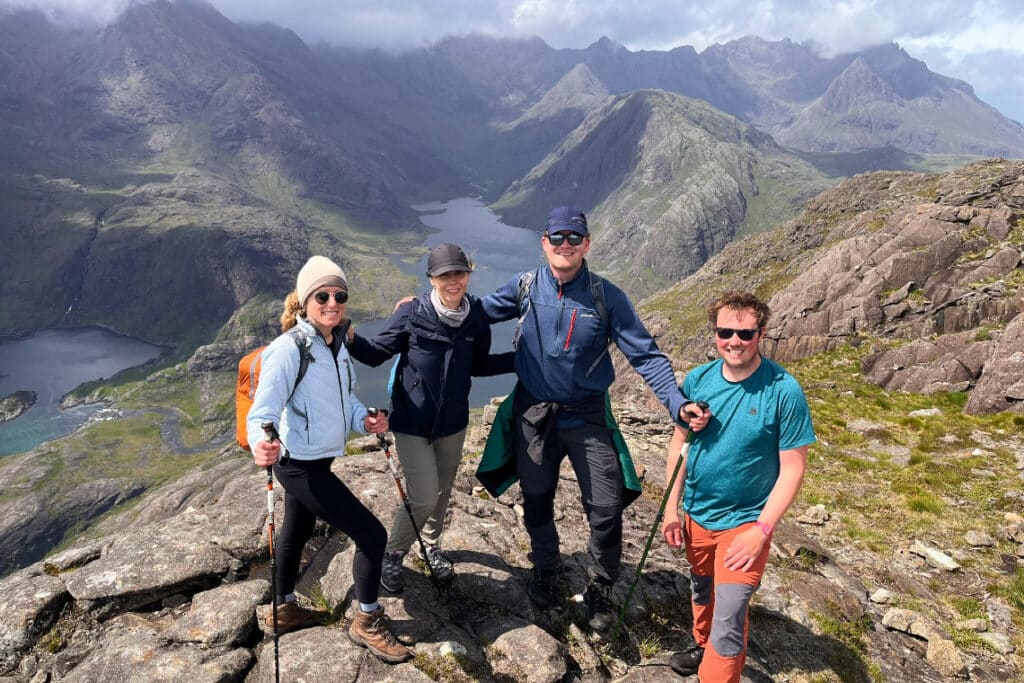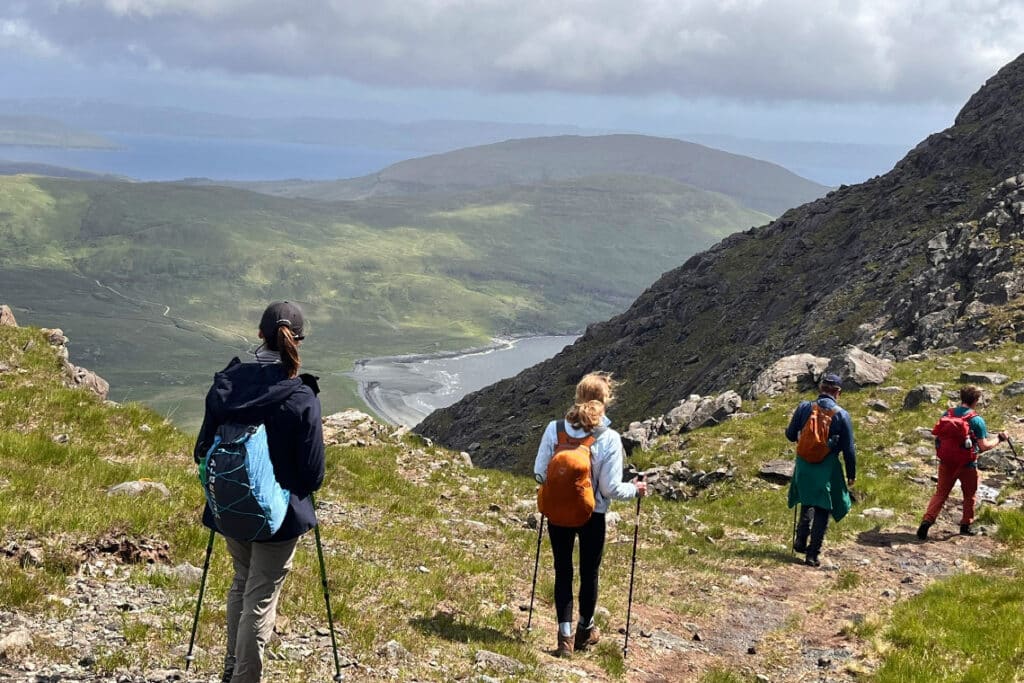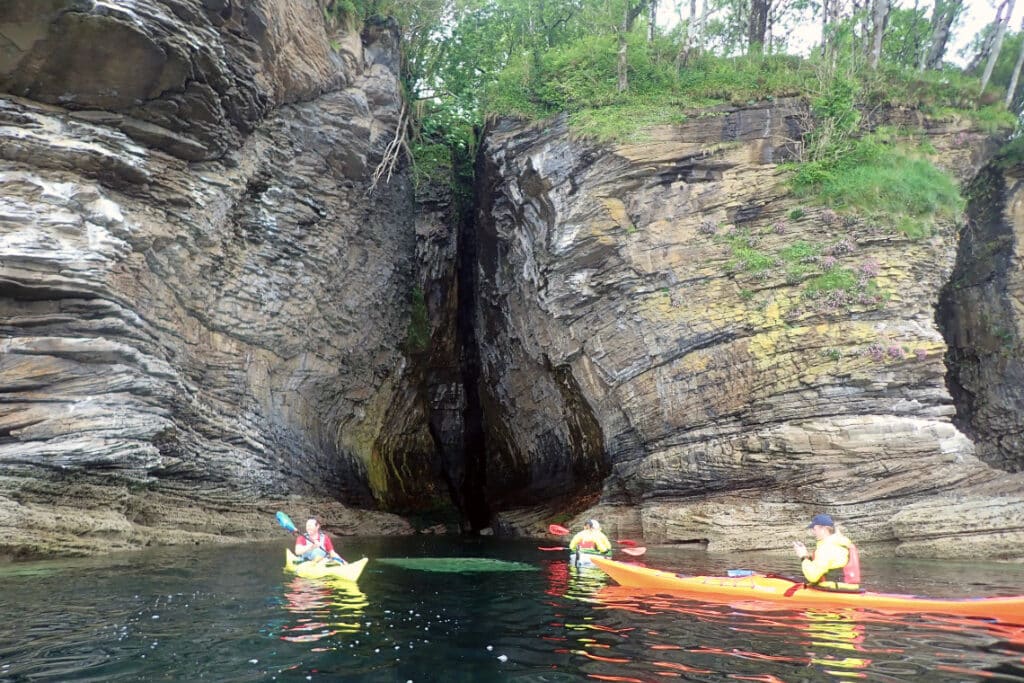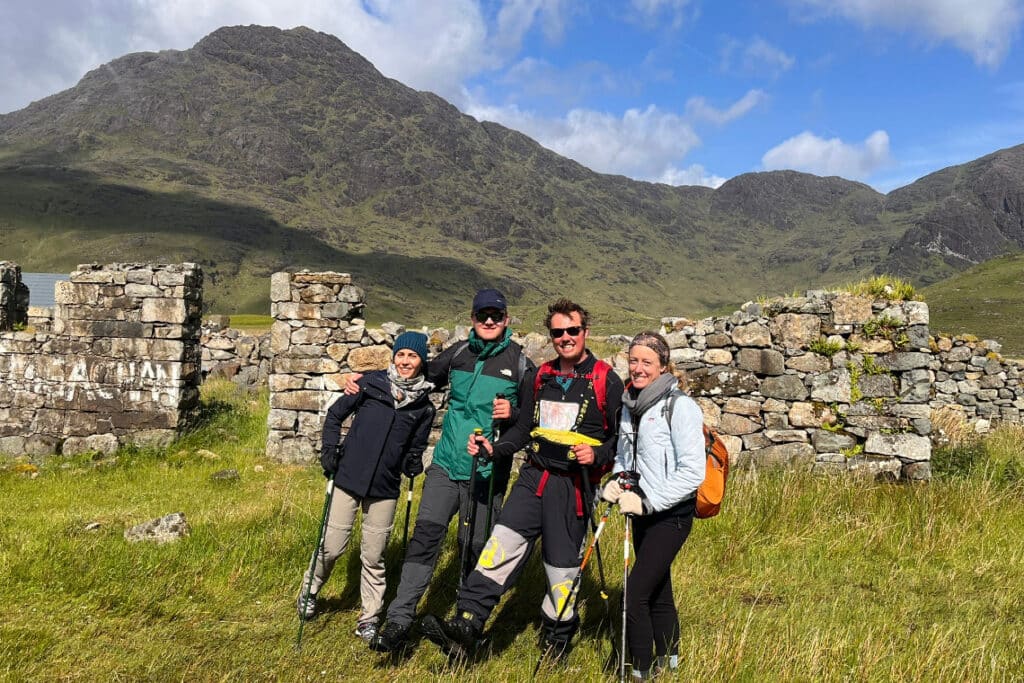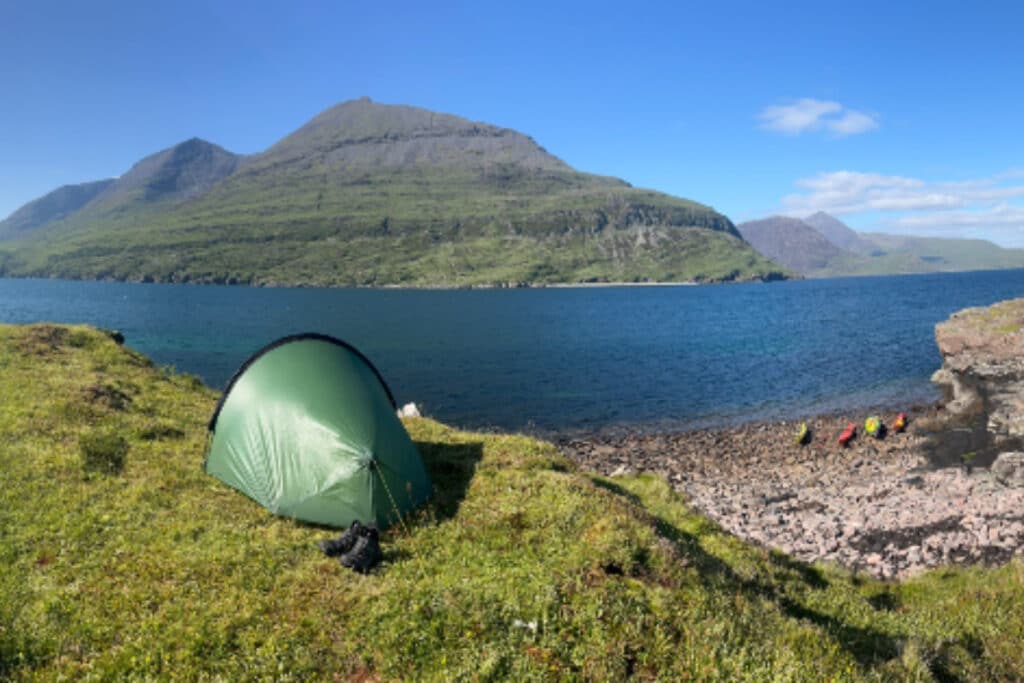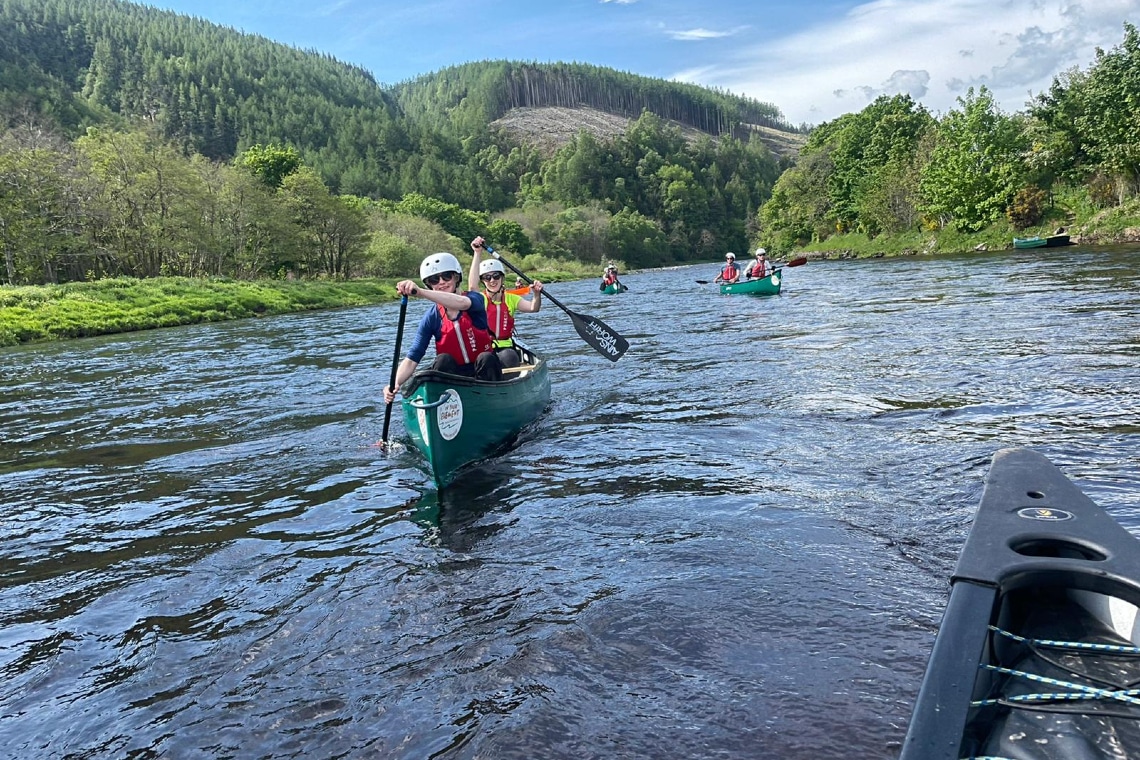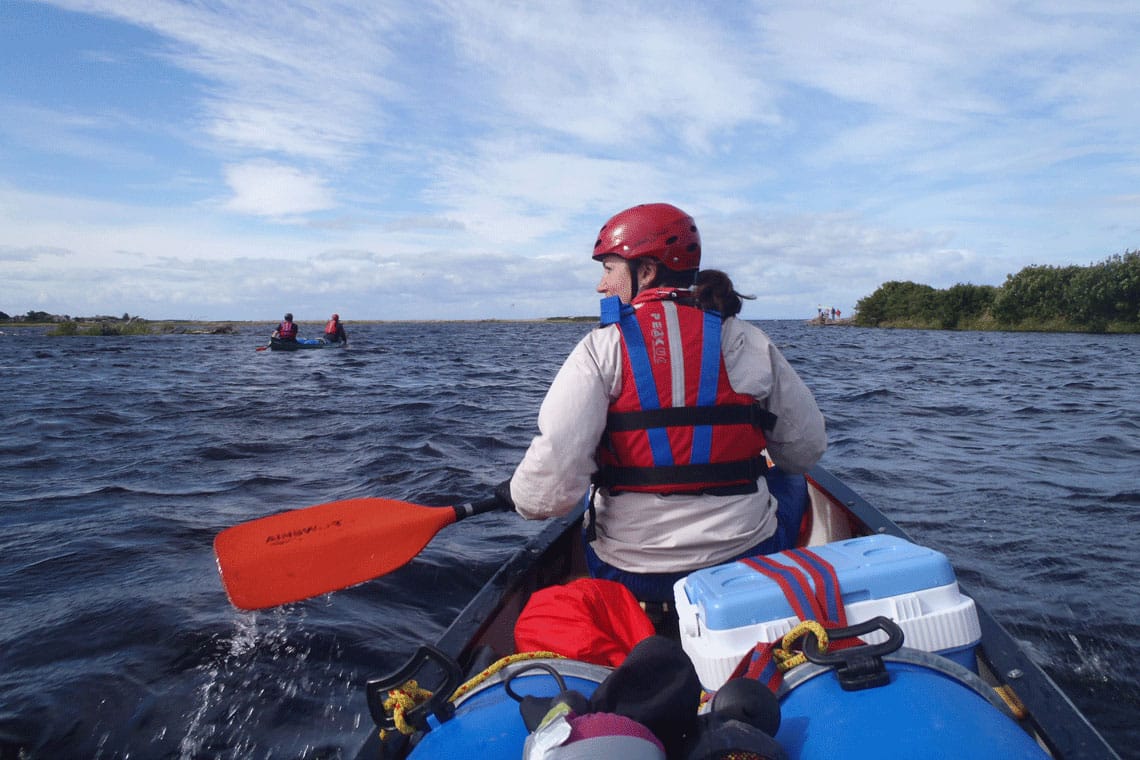Hike, Kayak and Wild Camp the Isle of Skye
Activity Overview
What to expect on this Isle of Skye Adventure?
- Sea kayak along Skye’s breathtaking southern coastline – eyes peeled for whales, seals, basking sharks, sea eagles and otters.
- Head into the Cuillin Mountains on a magnificent hike to the summit of Blà Bheinn for panoramic views over Skye.
- Circumnavigate Soay – an island populated by just three hardy souls – exploring sheltered lochs, secret caves and taking a dip in the ‘Mermaids Pool’.
- Pitch your tent in remote spots and enjoy a wee dram around the campfire, savouring the majesty of the Scottish Highlands.
Your Itinerary for the Adventure?
Day 1 – Welcome to the Scottish Highlands:
Meet up with your host in Inverness, the gateway to the Highlands. Hit the road for a 2.5-hour drive through gorgeous scenery, passing famous sights such as Loch Ness and Eilean Donan Castle, featured in the Highlander movie.
Cross over the Skye Bridge to the Isle of Skye and continue to the Strathaird Peninsula, stopping at Broadford for a quick bite to fuel your paddling spirit, and pick up your gear for the expedition. In the afternoon, you’ll launch into sheltered Loch Slapin, where a gentle paddle will unveil a coastline sculpted by nature’s artistry. Cracks, fissures, and caves dot the rugged landscape as you explore.
The highlight of this area will be a visit to the Spar Cave, a subterranean realm bathed in an ethereal glow, where you can wild swim (if you dare brave the icy waters!). Another hour’s paddle takes you to the first wild camp spot. Pitch up, get the fire going and settle in for dinner and camp out in the Scottish wilderness.
Day 2 – Circumnavigate & camp on a wild island
Tuck into a heary breakfast, break camp, load up the kayaks and hit the water for a full day exploring the southern Skye coastline. Paddle past headlands and outcrops before gliding past the secluded hamlet of Elgol, a charming village nestled amidst the rugged landscape. If the sea conditions allow, you’ll venture into open waters to reach the Isle of Soay, a remote island renowned for its unique breed of hardy sheep – and a population of three even hardier humans. The name ‘Soay’ comes from an old Norse word that literally means ‘sheep island’. Soay is nestled at the foot of the majestic Cuillin Mountains and makes for a captivating circumnavigation with its ever-changing coastline of cliffs, bays, arches and caves. Find a secluded spot to pitch your tent for a memorable night wild camping on Soay.
Day 3 – Loch Coruisk and the Black Cuillin
Wake up in this surreal spot, grab a coffee and bid farewell to the Isle of Soay, crossing back to the coastline of Skye. The focus of your journey shifts to the awe-inspiring Black Cuillin Mountains – one of the UK’s most challenging mountaineering terrains. Hug the shoreline with the imposing peaks of the Cuillin Ridge dominating the landscape. Keep a watchful lookout for golden and white-tailed eagles en route to the entrance to Loch Coruisk, a glacial lake that harbours a captivating legend. Loch Coruisk is said to be the abode of a kelpie, a mischievous water horse that can shapeshift into human form. Tread carefully, adventurers! After lunch, a leisurely 4km paddle takes you to Camasunary Beach, where you’ll set up basecamp for the next two nights. This secluded beach provides a tranquil setting nestled in the raw beauty of this part of Scotland.
Day 4 – Reach for the summit of a Skye mountain
Grab an early morning dip in the bracing Atlantic this morning, if you fancy (absolutely optional, of course!) before swapping your kayak for your hiking boots. Hike towards the Cuillin Mountains to the base of Blà Bheinn (929m), a magnificent Munro peak that stands as an outlier from the main Cuillin Ridge. This is one of the best day hikes in Skye, if not all of Scotland. A steady and at times steep ascent with over 900m of elevation gain, leads you all the way to the summit, which will require stamina and determination.
Blà Bheinn is a staggeringly scenic spot with unparalleled panoramic views of the Cuillins, neighbouring mountains and Scotland’s rugged west coast. Descend back down the mountain, eventually reaching camp where you can enjoy sunset before gathering around the campfire for your final night. Raise a glass of Talisker whisky, a spirit distilled just 10 miles away from your camp spot, adding a touch of Scottish warmth to the farewell celebration tonight.
Day 5 – The final stretch to the finish line
Bid farewell to this epic camp spot and stunning surroundings, completing the journey with a leisurely paddle back to Elgol village. The van will be waiting for you there, ready to whisk you away from the shores of Skye and back to Inverness. Along the way you’ll stop at a café or local shop for a final bite to savour the flavours of Scotland. Your host will drop you off in the town centre with a heartfelt farewell after a glorious time in the wilds.
Please note that traffic or weather conditions may cause delays today, so it’s advisable to avoid booking onward travel from Inverness until 17:00 at the earliest.
Suitability
You need to have some previous sea kayaking experience, as you will be exploring some remote areas and may encounter some lumpy sea conditions. We suggest a minimum of three days sea kayaking experience in the past. Additional training will be provided during the expedition, while on the water.
A generally good level of fitness will be required. Building some arm strength before the trip will help with sea kayaking, and good hip mobility is needed both for paddling and hiking. The precise difficulty level of this trip depends on the sea conditions at the time, which can change quickly, but you should come prepared to encounter some waves.
You will be in a single kayak by default: however, if perhaps you don’t have a lot of kayaking experience or aren’t confident paddling solo, and would prefer a tandem kayak, this can be requested with your host. These are subject to availability and dependent upon someone else being happy to paddle tandem with you. Please request this on your booking form.
What to Bring Along
A suggested expedition packing list will be provided on booking.
What’s Included
- An experienced guide
- Transport from Inverness and back.
- Great food.
- All camping, kayaking and cooking equipment (except sleeping bags).
- Sleeping Bags can be hired as an optional extra.
Map
Make a Booking
You can join this awesome expedition through our partners, Much Better Adventures. They have several dates scheduled and you can check current availability and book online using this link.FAQ’s
When you are choosing between public and private activity experiences, you’re not just weighing up the price or group size. You’re also asking:
- Will I feel comfortable?
- Will my group get enough attention?
- Is this going to feel like a bunch of strangers on a bus… or a personal experience?
So what is the difference between a private and public activity experience?
Public Tours – Perfect for solo travellers, couples, or small groups looking to meet others and share the experience. A fun, social vibe — more affordable and scheduled regularly.
Find out more about activities for Families, Small Groups, and Solo Travellers
Private Tours – Ideal for families, friend groups, or those wanting a more personalised pace. Customisable, flexible, and led with your preferences in mind. Subject to minimum booking fees, which may make it expensive for small groups.
Find out more about private group bookings here
If you’re still not sure what’s best for you, don’t hesitate to get in touch.
There are occasions when participants need to leave an expedition earlier than planned. This may be for a number of reasons, but might include illness, or perhaps they have simply underestimated the effort required to meet the challenge of the expedition. Although rare, when such occasions do arise, your hosts, In Your Element, reserve the right to charge £150 to collect an individual (with those travelling with them) and return them to central Inverness.
A collection would be subject to being able to reach an accessible location and the availability of a member of staff with a vehicle. So, collection may not be immediate. This extra charge covers unplanned staff time and the use of a vehicle & fuel, for what may be several hours in a day. In Your Element will be happy to provide a receipt, should you require it for insurance claim purposes.
You are, of course, more than welcome to make your own arrangements to leave, however, please be aware that the trips operate in some very remote locations, and taxis/public transport are not always readily available. We recommend that you take out suitable travel insurance to cover holiday cancellation costs or instances like those described above.
We can store anything you don’t need or want to take along on the expedition and return it to you when we collect you on the final day. You will decant your things into a 60-litre barrel – so it is best to organise your kit in a few smaller drybags (or similar) that can be squeezed in. This is because you won’t be able to fit your rucksack or duffle bag into the barrel or under the deck of a kayak.
Although we can provide waterproofs, we always recommend bringing along your own to wear as well. Our waterproofs are good for paddling in but your own are likely to be more comfortable for in camp at night. You should have a waterproof jacket and waterproof over-trousers (not just ‘water-resistant’). You don’t need to buy any specialist paddle clothing.
Weight limits for Kayak and Canoe Tours
Maximum Weight – 18 Stone (114 kg)
We limit participant weight to 18st (114 kg) because from the customer’s point of view:
– there is the safety aspect – i.e. their ability to exit the kayak safely in the event of a capsize (due to the limited size of the cockpit).
– This isn’t as much of an issue for canoe trips, but still makes things more difficult
– There is then the process of getting back in the kayak or canoe. We need to take customer weight into account because our expedition leader may need to rescue the paddler, and amongst other things, this would involve pulling them out of the water, and getting them back into the kayak or canoe, typically during bumpier water conditions. So the weight limit is also put in place to help our guides during rescues.
– During canoe expeditions, it is important that the 2 people paddling together in the canoe are roughly the same weight, otherwise the boat will be out of balance from back to front. This makes it more difficult to control the boat, particularly if windy.
– Finally, from comfort and practicality perspectives, customers will need to be able to get in and out of the kayak several times each day – it is particularly important to be able to do this quickly and unaided if, for example, landing on a beach at times when there a few waves around.
A Guide to Midges in Scotland
If you’re planning to explore Scotland’s stunning landscapes this summer, it’s advised to take precautions against attracting midges and other insects. Learn where to expect them and how best to avoid getting bitten.
FAQS about Midges
What are midges?
Small two-winged flies which often from swarms or clouds. There are a number of different species of midge, some of which partly feed off nectar in addition to the blood of animals and sometimes humans.
Which type of midge lives in Scotland?
The Highland midge. It’s found throughout the British isles, northern Europe and even northern China.
Are midges like mosquitos?
No. While midges might look like mosquitos close up and suck blood, they are not mosquitos and do not spread malaria.
What do midge bites look like?
Small red dots which can develop into itchy, painful swellings and even blisters.
Are midge bites serious?
Midge bites are harmless but if the skin around the bite becomes broken it could become infected.
How do midges detect their prey? The midge locates its prey by picking up carbon dioxide exhaled into the atmosphere.
Did you know? Only the female midge bites!
Where are the midge hotspots Scotland?
The west of the Highlands, islands and parts of the Cairngorms. They are also found in Perthshire and Argyll.
At what time of day are midges most active?
At dawn or dusk. They also like damp, clammy days with overcast skies and little wind.
At what time of year are midges most common?
From May to October.
Where are midges found?
Midges love humid and damp conditions as well as shady spots. Marshlands, grasslands, forests and woodlands, the banks of rivers, ponds and lochs; all are magnets for midges.
At what time of day are midges most active?
At dawn or dusk. They also like damp, clammy days with overcast skies and little wind.
What can you do about them?
We advise buy a midge-head net and possibly buy some insect repellent too, e.g. check the Smidge website. Midges won’t generally bother you during activities, but if they are around, you may bump into them if you are standing waiting, changing clothes, or resting during an activity.
In Your Element guides are local, experienced guys and girls that love doing what they do. They will be on hand to coach you, keep you safe, show you all the best campsites, tell you about what you see along the way, perhaps tell you a story or two, and they will be great camp-chefs (the quality of our camp-tucker is highly regarded!).
You’re always in good company on one of our adventures. Our trips are typically made up of a mixture of solo travellers and small groups of 2 or 3 friends, with most in their 30s-50s.
Our sociable adventures are solo-friendly by design and naturally attract outdoorsy people with a shared mindset; a love for adventure, a desire to push themselves and meet awesome, like-minded people along the way.
It’s this camaraderie that has so often turned a great adventure into a life-changing one.
All of our public, scheduled group adventures are specially designed for adults to enjoy (18+) as we want these adventures to bring together outdoorsy people who are truly like-minded. We may however, be able to cater for children on some private group departures. Just get in touch to find out more if this is of interest.
In Your Element don’t require you to have travel insurance, however, if booking through a partner company like Much Better Adventures, you will need it.
We do however, recommend that you have travel insurance, in case of holiday cancellations or illness, for example, prior to departure. None of the expeditions that we offer require ‘high-risk’ insurance cover.
Your insurance should include adequate protection for medical treatment, your baggage and equipment and the specific activities involved on your adventure. We also strongly recommend it includes cancellation and curtailment insurance, should you be unable to join your trip for specific reasons such as illness.
In Your Element has industry-leading Liability Insurance covering participants while on expedition. You will also be protected by Financial insolvency Insurance.
The Scottish summer is usually warm but you can expect some rain, even if it’s just a little. Prepare for anything and think ‘layers’. Conditions in May and September will be slightly cooler, with the potential for frost at night. Kit-wise, the main thing is a warm sleeping bag, and an additional bag liner if you feel the cold more.
If you are planning to join one of our scheduled departures through Much Better Adventures, for example, then yes, absolutely. You’ll be joining like-minded individuals, on a small, social expedition, so ideal for individuals to join.
For other expeditions that do not have online availability, then I’m afraid you won’t be able to do that as an individual. Generally speaking, we need a minimum of 4 people for a private group expedition to be viable for us.
Scottish weather can be unpredictable as most people will know. We will monitor weather forecasts in the lead up to your expedition departure date and we will have alternative routes in mind, should the weather look particularly bad. That may just mean starting somewhere else nearby and heading in a different direction, or at worst, we may need to consider a different location altogether. However, you can be assured that we will discuss this with you if the need arises.
Yes, you do.
You’ll either be sharing a canoe or kayak, perhaps paddling a kayak yourself, carrying a rucksack up a hill or your kit on a bike. We will give you suggested personal equipment lists prior to the expedition to help you pack sensibly. But do bear in mind you will need to carry your stuff and potentially some group equipment too.
Our adventure holiday offerings require different levels of experience depending on the location and nature of the expedition. However, all participants joining one of our expeditions should have a generally good level of fitness.
You may be expected to help lift equipment (like boats), carry your personal equipment and help with group kit. You may also spend a few hours paddling or cycling at a time, or walking with a heavy backpack. So, it goes without saying that any fitness preparation or conditioning you can do prior to the expedition, will help you enjoy it more.
Having said all that, most of our expeditions are aimed at less experienced indivudals, so we don’t expect you to be Olympic athletes!
Other Activities You Might Like
Reviews
 Great canoeing adventure for those looking to explore Loch Ness! Fantastic and fun experience all around!James and George (I hope I’m remembering their names correctly a few days after!!) were excellent guides and made the entire experience fun and effortless. We canoed all around Port Augustus, checking out Cherry Island, the unexplored coasts, and enjoying a quick break by a waterfall with shortbread and tea! Highly recommend this adventure to beginners and intermediate water sports adventurers if you’re looking to do more than cruise Loch Ness!
Great canoeing adventure for those looking to explore Loch Ness! Fantastic and fun experience all around!James and George (I hope I’m remembering their names correctly a few days after!!) were excellent guides and made the entire experience fun and effortless. We canoed all around Port Augustus, checking out Cherry Island, the unexplored coasts, and enjoying a quick break by a waterfall with shortbread and tea! Highly recommend this adventure to beginners and intermediate water sports adventurers if you’re looking to do more than cruise Loch Ness!
 Scotland West Coast Kayaking and Wild Camping Absolutely amazing 4 days away kayaking and wild camping. Stunning places to kayak, beach campsites to die for and a very experienced and knowledgeable host. First class experience, would definitely recommend.
Scotland West Coast Kayaking and Wild Camping Absolutely amazing 4 days away kayaking and wild camping. Stunning places to kayak, beach campsites to die for and a very experienced and knowledgeable host. First class experience, would definitely recommend. Great experience, highly recommended. This has been the highlight of our Highlands Holiday so far. We went on a 2.5hr canoe tour with Katie. She was amazing, very knowledgeable and made us feel safe & in control even when the wind made it a bit hairy. We met a fab group of people and had a blast. We are now thinking of doing the 5 day tour the length of the Caledonian canal.
Great experience, highly recommended. This has been the highlight of our Highlands Holiday so far. We went on a 2.5hr canoe tour with Katie. She was amazing, very knowledgeable and made us feel safe & in control even when the wind made it a bit hairy. We met a fab group of people and had a blast. We are now thinking of doing the 5 day tour the length of the Caledonian canal.
 Absolutely amazing 100k Canoe Across Scotland with wild camping. This was booked as I wanted a challenging experience for my birthday! Our guide Natasha was brilliant from start to finish. Very knowledgeable, friendly, chatty, helpful nothing was too much trouble for her and how she managed to make such amazing food in an outdoor kitchen is beyond belief. We had quite a mix of weather, sunny spells, cloud, rain, wind, thunderstorms. None of this made it any less enjoyable, in fact the strong wind and high waves on Loch Ness made for an exciting day! We got the sails out and later had to raft 2 canoes together for more stability, hard work but great fun. We camped at some lovely places along the way and beautiful varied scenery along the canals and lochs. Portering the canoes and all equipment around the lock gates especially at Fort Augustus can take a bit of time. I would like to say a big thank you not only to Natasha (our guide), but also the 5 ex commandos that completed the group and made our adventure more interesting!!! Would happily recommend this trip to anyone that enjoys a bit of outdoor adventure.
Absolutely amazing 100k Canoe Across Scotland with wild camping. This was booked as I wanted a challenging experience for my birthday! Our guide Natasha was brilliant from start to finish. Very knowledgeable, friendly, chatty, helpful nothing was too much trouble for her and how she managed to make such amazing food in an outdoor kitchen is beyond belief. We had quite a mix of weather, sunny spells, cloud, rain, wind, thunderstorms. None of this made it any less enjoyable, in fact the strong wind and high waves on Loch Ness made for an exciting day! We got the sails out and later had to raft 2 canoes together for more stability, hard work but great fun. We camped at some lovely places along the way and beautiful varied scenery along the canals and lochs. Portering the canoes and all equipment around the lock gates especially at Fort Augustus can take a bit of time. I would like to say a big thank you not only to Natasha (our guide), but also the 5 ex commandos that completed the group and made our adventure more interesting!!! Would happily recommend this trip to anyone that enjoys a bit of outdoor adventure.
 100k Canoe Across Scotland - Amazing It was a fantastic experience with a great guide and great food. The lochs and canals are beautiful. The small group dynamics worked well. It was a hard trip, with long days of paddling, but it was worth the challenge. The wild camping locations were pretty. The hardest part was getting out, unloading the canoes, carrying them, and then repacking them at each loch gate - that was very tiring. Toilet stops at each gate was really appreciated lol. Sailing a canoe was a new experience - when the wind got strong on Loch Ness, we got to put up sails to go faster. The food the guide cooked was fantastic. He (Adian) was funny, friendly, and concerned about the environment - having us check for other people's rubbish at each camp site - it was great.
100k Canoe Across Scotland - Amazing It was a fantastic experience with a great guide and great food. The lochs and canals are beautiful. The small group dynamics worked well. It was a hard trip, with long days of paddling, but it was worth the challenge. The wild camping locations were pretty. The hardest part was getting out, unloading the canoes, carrying them, and then repacking them at each loch gate - that was very tiring. Toilet stops at each gate was really appreciated lol. Sailing a canoe was a new experience - when the wind got strong on Loch Ness, we got to put up sails to go faster. The food the guide cooked was fantastic. He (Adian) was funny, friendly, and concerned about the environment - having us check for other people's rubbish at each camp site - it was great.


 Great trip even though wet We look a canoe trip with on of their guides and one other in 2 Canadian canoes along the Loch at Forest Holidays Strathyre . Guide was great and the scenery was too.
Great trip even though wet We look a canoe trip with on of their guides and one other in 2 Canadian canoes along the Loch at Forest Holidays Strathyre . Guide was great and the scenery was too. Superb trip: great organisation and delivery I have just returned from an IYE canoeing adventure from Fort William to Inverness, with seven friends. It was a fantastic experience: superbly organised and delivered by our guide Andy Russell and the IYE team. I was hugely impressed with the thought behind and safety of the trip, particularly the care taken to select breathtaking camping spots, and actually the attention to detail for every aspect! Andy, in particular was outstanding: reliable and organised, of course, a knowledgeable and inspiring guide who made all the right decisions, and an absolutely first class chef across all four nights. He was also just great company. We will recommend IYE widely!
Superb trip: great organisation and delivery I have just returned from an IYE canoeing adventure from Fort William to Inverness, with seven friends. It was a fantastic experience: superbly organised and delivered by our guide Andy Russell and the IYE team. I was hugely impressed with the thought behind and safety of the trip, particularly the care taken to select breathtaking camping spots, and actually the attention to detail for every aspect! Andy, in particular was outstanding: reliable and organised, of course, a knowledgeable and inspiring guide who made all the right decisions, and an absolutely first class chef across all four nights. He was also just great company. We will recommend IYE widely!
 Awesome Team Searched on TripAdvisor for reliable vendor for guided canoeing experience, eventually narrowed down to In Your Element as they had the date available in early April, turns out our activity was the first of the season. Cut the story short, I was staying in Inverness and didn't realised how inaccessible public transport was to get to Fort Augustus (meeting point) by 10am, Calum at the IYE office was fantastic, he helped to contact the rest of the guests on the same activity to seek agreement to push back the start time by 15mins, saving me to miss the activity which was the highlight of my trip to Scotland. Our guide Jack was friendly and helpful, the canoes look new and well maintained. Though the weather was cloudy with slight rain, overall it was still a memorable experience canoeing on Loch Ness!
Awesome Team Searched on TripAdvisor for reliable vendor for guided canoeing experience, eventually narrowed down to In Your Element as they had the date available in early April, turns out our activity was the first of the season. Cut the story short, I was staying in Inverness and didn't realised how inaccessible public transport was to get to Fort Augustus (meeting point) by 10am, Calum at the IYE office was fantastic, he helped to contact the rest of the guests on the same activity to seek agreement to push back the start time by 15mins, saving me to miss the activity which was the highlight of my trip to Scotland. Our guide Jack was friendly and helpful, the canoes look new and well maintained. Though the weather was cloudy with slight rain, overall it was still a memorable experience canoeing on Loch Ness!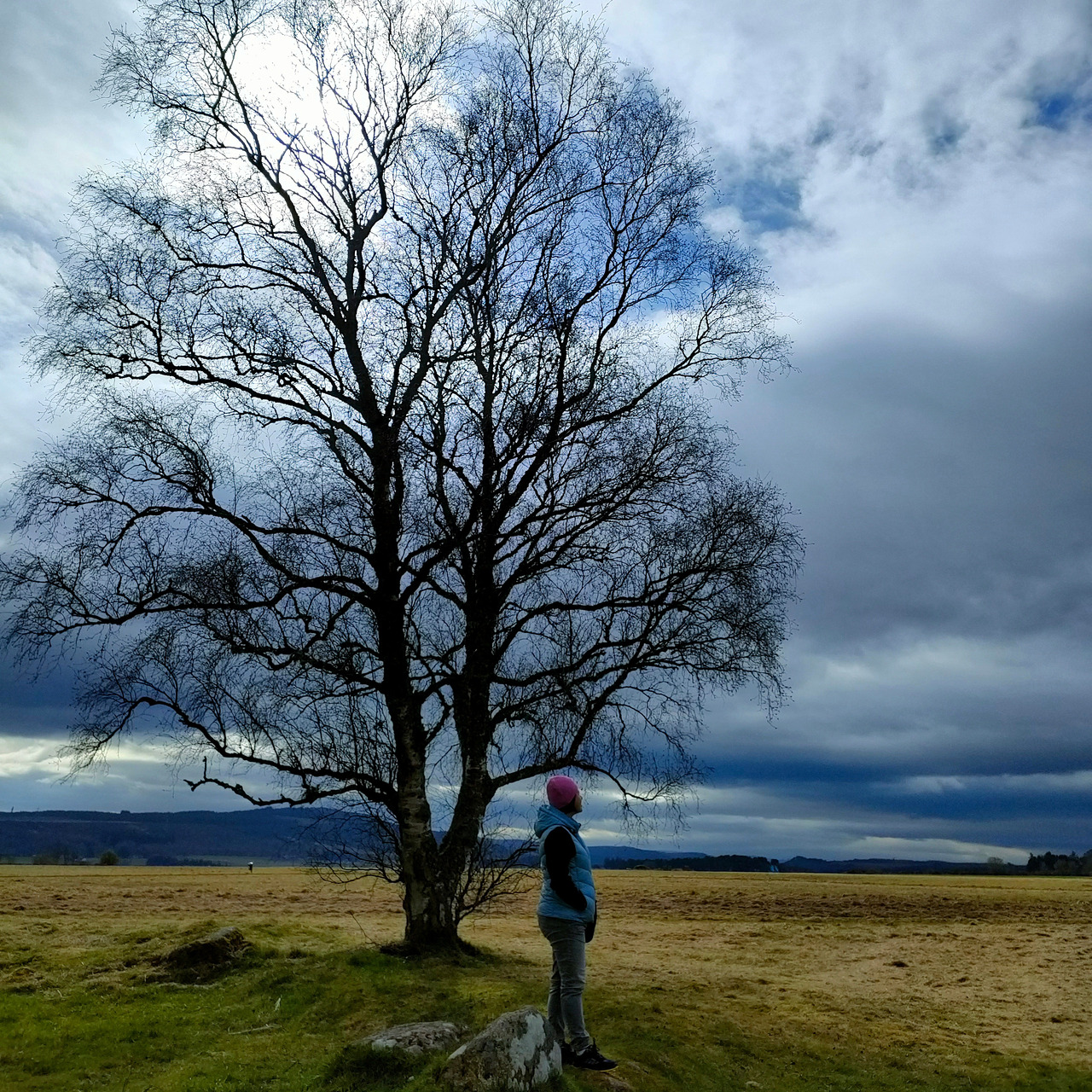


 Gorge walking is our new favourite thing to do!!! Great afternoon gorge walking in Culloden. Our guide Colin was fab and ensured we all had an amazing experience. If you're in the area this is a must!
Gorge walking is our new favourite thing to do!!! Great afternoon gorge walking in Culloden. Our guide Colin was fab and ensured we all had an amazing experience. If you're in the area this is a must! Great fun We stayed at Loch Tay highland lodges and one of the main reasons was you could book activities to keep us busy whilst there for the 5 nights. We pretty much did everything they had on offer Canoe tour 🛶 We did this with Giles as our guide, he’s a great guy and we where the only ones booked on that morning which made it very personal Archery class 🏹 There was 7 of us on this with Tim so a bit of waiting around but a good laugh none the less Segway tour ⚙️ Again we ended up being the only ones on this with Giles, which was great as we got going a lot quicker, this is so much fun I laughed all the way We hired a boat for the day 🚤 At one point we where the only ones on the Loch that we could see, so peaceful and the sun can out! Paddle boarding 🏄♂️ We hired paddlebards and wet suites for 3 hours, the sun came out we paddled round to a little beach and back really good fun All the activities were great fun, the staff where lovely. If you are staying at Loch Tay get a few things booked as something to look forward to
Great fun We stayed at Loch Tay highland lodges and one of the main reasons was you could book activities to keep us busy whilst there for the 5 nights. We pretty much did everything they had on offer Canoe tour 🛶 We did this with Giles as our guide, he’s a great guy and we where the only ones booked on that morning which made it very personal Archery class 🏹 There was 7 of us on this with Tim so a bit of waiting around but a good laugh none the less Segway tour ⚙️ Again we ended up being the only ones on this with Giles, which was great as we got going a lot quicker, this is so much fun I laughed all the way We hired a boat for the day 🚤 At one point we where the only ones on the Loch that we could see, so peaceful and the sun can out! Paddle boarding 🏄♂️ We hired paddlebards and wet suites for 3 hours, the sun came out we paddled round to a little beach and back really good fun All the activities were great fun, the staff where lovely. If you are staying at Loch Tay get a few things booked as something to look forward to
 Gorge scrambling Culloden Went Gorge scrambling at Culloden. So easy to book, really friendly staff, all equipment provided, and catered to all levels. Amazing way to see nature otherwise untouched and such a fun start to NC500.
Gorge scrambling Culloden Went Gorge scrambling at Culloden. So easy to book, really friendly staff, all equipment provided, and catered to all levels. Amazing way to see nature otherwise untouched and such a fun start to NC500. Great canoeing on Loch Ness Went canoeing with a group from work, Scott was friendly and helpful and put some of the more nervous team members at ease on the water. Saw Loch Ness from a different angle than the roadside. Great fun, and a cup of tea too!
Great canoeing on Loch Ness Went canoeing with a group from work, Scott was friendly and helpful and put some of the more nervous team members at ease on the water. Saw Loch Ness from a different angle than the roadside. Great fun, and a cup of tea too!
 Amazing gorge walking experience What an amazing experience this was. Colin the guide was fabulous and gave us lots of local knowledge and introduced us to the gorge and it’s many amazing and interesting features. The gorge walking was brilliant. We had the opportunity to jump into deep water and slide down a waterfall. It was exciting and exhilarating and such a pleasure to be guided by Colin. He encouraged us to make the jumps and I’m glad he did as we would have regretted not doing them. We did the jumps again we enjoyed them so much. I have already booked to do it again next week. Would definitely recommend. Thanks In Your Element
Amazing gorge walking experience What an amazing experience this was. Colin the guide was fabulous and gave us lots of local knowledge and introduced us to the gorge and it’s many amazing and interesting features. The gorge walking was brilliant. We had the opportunity to jump into deep water and slide down a waterfall. It was exciting and exhilarating and such a pleasure to be guided by Colin. He encouraged us to make the jumps and I’m glad he did as we would have regretted not doing them. We did the jumps again we enjoyed them so much. I have already booked to do it again next week. Would definitely recommend. Thanks In Your Element
 Great adventure, kayaking on Loch Ness Kayaking on Loch Ness, we had a great morning taking in the views on Loch Ness, great family adventure enjoyed by all, although I was shattered at the end but that is just a reflection on my fitness level. Our guide, Matt, was brilliant, the right amount of information given, humour and making sure all members of our group were ok. Would definitely recommend this trip.
Great adventure, kayaking on Loch Ness Kayaking on Loch Ness, we had a great morning taking in the views on Loch Ness, great family adventure enjoyed by all, although I was shattered at the end but that is just a reflection on my fitness level. Our guide, Matt, was brilliant, the right amount of information given, humour and making sure all members of our group were ok. Would definitely recommend this trip.
 Great Adventure We went gorge walking near Inverness and it was a fantastic experience with good guidance from Colin
Great Adventure We went gorge walking near Inverness and it was a fantastic experience with good guidance from Colin Breathtaking highland experience. One of the best experiences I've had, the guides were excellent, they made it easy and really really enjoyable and fun. The scenery was breath taking, the food good and the company even better. I cannot recommend this trip or the people highly enough.
Breathtaking highland experience. One of the best experiences I've had, the guides were excellent, they made it easy and really really enjoyable and fun. The scenery was breath taking, the food good and the company even better. I cannot recommend this trip or the people highly enough.
 Greta fun and enjoyment for all ages. We arranged for archery and canoeing at Ardgarten for our three grandchildren and their mum and they had an absolutely fantastic time. Made all the better with Kyle their instructor who went above and beyond to make sure they had a great time. I would highly recommend the experience.
Greta fun and enjoyment for all ages. We arranged for archery and canoeing at Ardgarten for our three grandchildren and their mum and they had an absolutely fantastic time. Made all the better with Kyle their instructor who went above and beyond to make sure they had a great time. I would highly recommend the experience.
 GREAT experience for first time on the Loch Ness!!!!! We did canoeing on the Loch Ness with Scott D as our guide and it was FANTASTIC. Well well worth the price and such a great experience. Scott was an excellent guide and made sure to try and talk with everyone in the group. He gave a lot of great information about Scotland, the local area, the Loch Ness, etc. Pretty much the PERFECT guide! He even remembered that it was my birthday and bought me a special cupcake!! We only had one day to spend on the Loch Ness and we are so glad that we did this tour. I hope one day they offer a longer tour like an all day one with lunch and coffee breaks on islands included.
GREAT experience for first time on the Loch Ness!!!!! We did canoeing on the Loch Ness with Scott D as our guide and it was FANTASTIC. Well well worth the price and such a great experience. Scott was an excellent guide and made sure to try and talk with everyone in the group. He gave a lot of great information about Scotland, the local area, the Loch Ness, etc. Pretty much the PERFECT guide! He even remembered that it was my birthday and bought me a special cupcake!! We only had one day to spend on the Loch Ness and we are so glad that we did this tour. I hope one day they offer a longer tour like an all day one with lunch and coffee breaks on islands included.
 Fantastic fun experience for all the family! Our instructor Scott took our family of six out on a fun paddle on Loch Ness. Even our younger two (age 5 and 7) had their own paddles and felt part of the experience! Loch Ness is beautiful and we had the weather on our side. Scott was super friendly and full on info. He gave us clear instructions that we all could follow easily. Definitely recommend!!
Fantastic fun experience for all the family! Our instructor Scott took our family of six out on a fun paddle on Loch Ness. Even our younger two (age 5 and 7) had their own paddles and felt part of the experience! Loch Ness is beautiful and we had the weather on our side. Scott was super friendly and full on info. He gave us clear instructions that we all could follow easily. Definitely recommend!!
 A breathtaking experience on Loch Ness We, a family of 4, had the pleasure to spend a morning with Colin and Aiden on Loch Ness for a canoe experience We were extremely lucky with the weather and the Loch was calm and like in a movie. But we were also extremely lucky with our instructors Colin and Aiden. Colin is very experienced and knows so many things about the lake and about canoeing. Aiden was newer to the job, but by no mean a rookie. Both were very friendly, helpful and fun to be around. They showed us the hidden waterfalls and took pictures of us as a family. The experience on the lake was simply amazing. It felt like we were the only one in the world. Thanks to Colin and Aiden, I would definitely recommend them!
A breathtaking experience on Loch Ness We, a family of 4, had the pleasure to spend a morning with Colin and Aiden on Loch Ness for a canoe experience We were extremely lucky with the weather and the Loch was calm and like in a movie. But we were also extremely lucky with our instructors Colin and Aiden. Colin is very experienced and knows so many things about the lake and about canoeing. Aiden was newer to the job, but by no mean a rookie. Both were very friendly, helpful and fun to be around. They showed us the hidden waterfalls and took pictures of us as a family. The experience on the lake was simply amazing. It felt like we were the only one in the world. Thanks to Colin and Aiden, I would definitely recommend them!
 Canoeing with Colin My boyfriend and I had a wonderful experience canoeing on Loch Ness. Colin was our guide and he was very knowledgeable and provided lots of interesting facts and figures about the history of Loch Ness. It was my first time canoeing and he was very patient and gave good instruction for beginners.
Canoeing with Colin My boyfriend and I had a wonderful experience canoeing on Loch Ness. Colin was our guide and he was very knowledgeable and provided lots of interesting facts and figures about the history of Loch Ness. It was my first time canoeing and he was very patient and gave good instruction for beginners.
 Loch Ness Canoeing with Colin. Last week me and my partner did canoing on Loch Ness with Colin. Definitely recommend the taster session as we were worried it would be too short but it was perfect!! Colin was very knowledgeable in using the canoes, the history of Loch Ness & be made it very fun and interesting!! They take photos free of charge which is great as the boats are very wobbly and you don’t want to drop your phone. Personalised the trip to all participants. Nice and easy. Would definitely do this again if we return in the future. A great activity for your trip.
Loch Ness Canoeing with Colin. Last week me and my partner did canoing on Loch Ness with Colin. Definitely recommend the taster session as we were worried it would be too short but it was perfect!! Colin was very knowledgeable in using the canoes, the history of Loch Ness & be made it very fun and interesting!! They take photos free of charge which is great as the boats are very wobbly and you don’t want to drop your phone. Personalised the trip to all participants. Nice and easy. Would definitely do this again if we return in the future. A great activity for your trip.
 Canoeing trip with friends Brilliant canoeing trip thanks to IYE. Really helpful and friendly staff would definitely recommend them if you're thinking of organising a trip.
Canoeing trip with friends Brilliant canoeing trip thanks to IYE. Really helpful and friendly staff would definitely recommend them if you're thinking of organising a trip. An Epic Adventure! We had an afternoon of Gorge Swimming with Colin at Bridge of Brown and it was utterly amazing. As a group of 8 friends, on a clearly swollen river, in winter, there was some trepidation. Colin was an absolute legend though; clear instruction, answered all our questions and gave us great advice. All the equipment we required was supplied and was top notch. We were in the water for the perfect amount of time. Everyone came out exhausted, but exhilarated. Can't recommend giving this a go enough. Many thanks to Colin and In Your Element. An experience we all agree we'll never forget!
An Epic Adventure! We had an afternoon of Gorge Swimming with Colin at Bridge of Brown and it was utterly amazing. As a group of 8 friends, on a clearly swollen river, in winter, there was some trepidation. Colin was an absolute legend though; clear instruction, answered all our questions and gave us great advice. All the equipment we required was supplied and was top notch. We were in the water for the perfect amount of time. Everyone came out exhausted, but exhilarated. Can't recommend giving this a go enough. Many thanks to Colin and In Your Element. An experience we all agree we'll never forget!
 Wonderful canoe on Loch Ness! We did a Guided Canoe Taster with our guide Collin and it was fantastic! Collin was extremely knowledgable about Loch Ness and gave us great information during the trip. The activity was very easy going and relaxing and towards the end we were paddling against the current as a fun challenge. Collin also gave us a ton of recommendations for things to do in the Loch Ness area. Would definitely recommend to anyone going to the Loch Ness region!
Wonderful canoe on Loch Ness! We did a Guided Canoe Taster with our guide Collin and it was fantastic! Collin was extremely knowledgable about Loch Ness and gave us great information during the trip. The activity was very easy going and relaxing and towards the end we were paddling against the current as a fun challenge. Collin also gave us a ton of recommendations for things to do in the Loch Ness area. Would definitely recommend to anyone going to the Loch Ness region!
 Amazing canoeing experience on Loch Ness with Gavin We did a canoeing tour along the Loch Ness with Gavin. It was incredible! It felt like we were the only people there- canoeing is definitely a great way to get a real feel for the famous lake. We got lucky and had fantastic, clear weather and were able to reach the waterfalls - roughly 40 mins paddling from Fort Augustus. Definitely one of our top highlights from our Highlands trip!
Amazing canoeing experience on Loch Ness with Gavin We did a canoeing tour along the Loch Ness with Gavin. It was incredible! It felt like we were the only people there- canoeing is definitely a great way to get a real feel for the famous lake. We got lucky and had fantastic, clear weather and were able to reach the waterfalls - roughly 40 mins paddling from Fort Augustus. Definitely one of our top highlights from our Highlands trip!


 Amazing 100km Canoe tour! I have just come back from the 100km canoe tour provided by In your Element and hosted by our guide, Colin. This was a truly excellent adventure. We were provided with all the equipment you might need and not only is Colin an expert guide on almost every single sport/activity you can imagine, but he's also a fantastic chef! 3-course meals every night on the edge of a beautiful Loch. It doesn't get much better than that. I would highly recommend this adventure to anyone and everyone!
Amazing 100km Canoe tour! I have just come back from the 100km canoe tour provided by In your Element and hosted by our guide, Colin. This was a truly excellent adventure. We were provided with all the equipment you might need and not only is Colin an expert guide on almost every single sport/activity you can imagine, but he's also a fantastic chef! 3-course meals every night on the edge of a beautiful Loch. It doesn't get much better than that. I would highly recommend this adventure to anyone and everyone!


 Loch Tay explorer Half day Hired the explorer boat for 3 hours on Tuesday 21st on Loch Tay. Richie showed us how to use the bit and was very informative. Clean boat and the views all around the loch and surrounding areas were fantastic. My 1 year old decided to have an hour nap while my 3 year old sat on my knee steering the boat. Fantastic memories, Thank you
Loch Tay explorer Half day Hired the explorer boat for 3 hours on Tuesday 21st on Loch Tay. Richie showed us how to use the bit and was very informative. Clean boat and the views all around the loch and surrounding areas were fantastic. My 1 year old decided to have an hour nap while my 3 year old sat on my knee steering the boat. Fantastic memories, Thank you
 100km Great Glen Canoeing What a fantastic canoeing and wild camping experience. Hard to describe in words. Everything was organised so well, stunning scenery and proper scottish weather. A big thank you to our guide Colin, who made this amazing trip EPIC!!
100km Great Glen Canoeing What a fantastic canoeing and wild camping experience. Hard to describe in words. Everything was organised so well, stunning scenery and proper scottish weather. A big thank you to our guide Colin, who made this amazing trip EPIC!! Perfect nature trip in Scotland 100km canoe trip across Scotland: The sheer amount of smooth organization for our trip through wavey, windy and rainy lochs was amazing! Meeting a person who is doing exactly what they are supposed to be doing is very rare - but our guide Colin was one of them! He was able to steer us through difficult water, explain every animal, vegetation or sports questions we had. Food, equipement, organization and guide of In Your Element was on point! Thank you Colin for being one of us while showing us the way. To watch him excel in his Element was just as amazing as the scenery around us. What an adventure to have with the greatest people in our group! Cheers to us and knowing when to rudder or side sweep 🙂
Perfect nature trip in Scotland 100km canoe trip across Scotland: The sheer amount of smooth organization for our trip through wavey, windy and rainy lochs was amazing! Meeting a person who is doing exactly what they are supposed to be doing is very rare - but our guide Colin was one of them! He was able to steer us through difficult water, explain every animal, vegetation or sports questions we had. Food, equipement, organization and guide of In Your Element was on point! Thank you Colin for being one of us while showing us the way. To watch him excel in his Element was just as amazing as the scenery around us. What an adventure to have with the greatest people in our group! Cheers to us and knowing when to rudder or side sweep 🙂


 Unforgettable experience Can't describe how brilliant the great Glenn canoe trip was, it was such an amazing character building experience that I will never forget! Colin was the perfect guide with knowledge and expertise. The food was incredible and I took home memories I shall always cherish. I met an amazing group of people and could not recommend this trip more! Big shout out to Colin and I will certainly be heading out with IYE again!
Unforgettable experience Can't describe how brilliant the great Glenn canoe trip was, it was such an amazing character building experience that I will never forget! Colin was the perfect guide with knowledge and expertise. The food was incredible and I took home memories I shall always cherish. I met an amazing group of people and could not recommend this trip more! Big shout out to Colin and I will certainly be heading out with IYE again!
 5 day Scotland Canoe Expedition What an incredible experience! I do not know how else to describe this trip. Sending a very big thank you to Colin for your knowledge, support, personality and eagerness to create the experience that it was. From the get go, everything was well organised, prepped and executed seamlessly. We met some wonderful people and made new friends where together, we made it through the rough weather. It was a trip to remember and we will certainly be back to Scotland sooner than later! Thanks Captain Colin! 💪🚣🛶
5 day Scotland Canoe Expedition What an incredible experience! I do not know how else to describe this trip. Sending a very big thank you to Colin for your knowledge, support, personality and eagerness to create the experience that it was. From the get go, everything was well organised, prepped and executed seamlessly. We met some wonderful people and made new friends where together, we made it through the rough weather. It was a trip to remember and we will certainly be back to Scotland sooner than later! Thanks Captain Colin! 💪🚣🛶


 Amazing experience Just come back from the 5 day canoe expedition up the great Glen and it was amazing. The views and surroundings are incredible. The guide Colin was incredibly knowledgeable about canoeing and the local area and kept us topped up with facts along the way. He certainly made the trip what is was!!
Amazing experience Just come back from the 5 day canoe expedition up the great Glen and it was amazing. The views and surroundings are incredible. The guide Colin was incredibly knowledgeable about canoeing and the local area and kept us topped up with facts along the way. He certainly made the trip what is was!!

